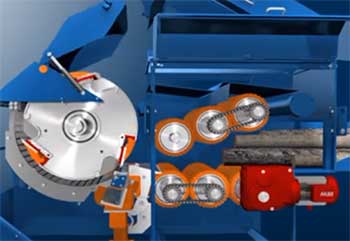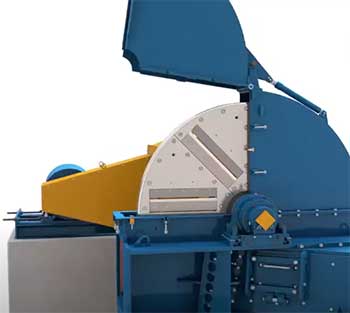If you’ve been running back and forth on disc and drum chippers, this article will help you. But is one of these knives better than the other? The main difference between them is in their efficiency levels.
However, there’s more to understand and uncover about them. And we’re here to break it down for you. Which of these knives shall serve your purpose best? Keep reading to know as we talk about their distinctions, similarities, key features, and more!
A Quick Comparison Table
| Specifications | Drum Chipper | Disc Chipper |
| Blade | Scoop style | On the disc’s face |
| Cut | Horizontal orientation | Approximately 90-degree angle |
| Velocity | Good | Great |
| Construction | Compact, heavy & durable | Sturdy build |
| Size | Compact | Size and weight vary. |
| Portability | Easy | Tough |
| Ergonomic | High | Low |
| Usability | Excellent | Good |
| Efficiency | Low | High |
| Productivity | High | Low |
| Chip Quality | Less uniform | Uniform |
Key Difference Between Drum Chipper And Disc Chipper
- The Blades

Let’s begin with the basics – the knives.
In drum chippers, the blades are cut in a scooping style and motion and are mounted at a horizontal angle and orientation.
Generally, drums have some space at the back of the feed rollers, which minimizes accidents as it lowers the chances of clothes or jewelry getting jammed and lodged inside or at the rear end.
On the other hand, the knives in the disc chippers are installed on the face of the appliance. It can cut through grains of wood at approximately 90-degree angles. Users can determine the disc’s size by first analyzing the material’s proportions.
- Cutting Performance
Generally, the disc chipper comes with incredible velocity during chipping and cutting wood. Moreover, it’s an excellent specification simply because timber is a fibrous material requiring greater assistance.
On the other hand, drum chippers have rotational functionality and can make broader cuts than discs.
Drum chips are also more compact in size and construction, but the build is incredibly durable and robust. However, users believe that since drums are a bit heavier, they often deliver poorly chipped timber discharge.
- Size
Both cutting blades are constructed with rotating mass. Hence, most heavy-duty work is done through this equipment, starting from the mid to the bottom of the machine. However, there are other differences between them, including their sizes.
A disc chipper utilizes half of its disc; thus, if the chipper’s size increases, you will need a more extensive disc than the drum chipper. Therefore, a disc chipper’s overall weight and size naturally increase even though the drum chipper is heavier.
Moreover, after judging the size of the chipper, one must base their decision on the material they’re opting to chop before beginning.
- Usability

Some disc chippers operate at 90 degrees while others, like the flywheel, discharge at 270-degree.
It’s a give-and-take between the specifications based on the project you’re partaking in.
Now, since there are larger disc chippers in the market, they come with higher chutes for filling the bins and require trailers to move.
They’re towable but more challenging to move and less ergonomic than drum chippers.
Drum chippers have a wider hopper, so there are lower trims before chipping, and users get easier accessibility for sharpening and servicing the blades.
- Efficiency
According to research, drum chippers have lower efficiency rates than disc chippers. In comparison, the disc chipper utilizes 19% lower fuel for every unit product than drum chippers.
Now, disc chippers can effectively do so as it comes with a synergistic design, seamless discharge systems, integrated comminutes, and straightforward design.
However, research also shows that the drum chipper has an 8% higher productivity rate than disc chippers as it exhibits the same energy during the cuts, and the knives run along the wood’s length, saving more.
- Quality
When it comes to cut quality, it’s well-known that disc chippers deliver uniform cuts rather than drum chippers. Moreover, this phenomenon also heavily relies on the type, size, and quantity of wood fed into the system. For instance, disc chippers deliver uniform cuts, especially when it’s raw material.
On the other hand, drum chippers are far more productive since it operates on constant energy levels and their knives run along the length of the materials.
Which Chipper Is Better For You?
So, what do you think? Which chipper attracts your needs the most? It’s best to make this decision based on a few factors, mainly your budget and which type of project you take on the most.
Let’s give it to your straight, these are both hefty investments, but users are more inclined toward drum chippers due to their higher ergonomics, portability, and more straightforward usability.
So, if your project and wood type can be satisfied with drum chippers, you can make the splurge in a blink. But, in retrospect, if you require the highest efficiency, then disc chippers are the right product.
Frequently Asked Questions (FAQ)
Disc chippers have high energy efficiency, which utilizes around 19% lower fuel/unit for each product due to its intuitive design, discharging system, integrated comminutes, and synergy. In retrospect, the drum chipper has 8% higher productivity.
Drum chippers can efficiently operate on waste wood, veneer residues, offcuts, slabs, long ends, and round timber. The wood is fed into the chipper through a vibrating conveyer or feeder belt.
Disc chippers can cut and chip wooden timbers, logs, and other materials with specialized designs. The wood is cut into top-notch wooden shavings and chips with uniform thickness, well-distributed length, and a flat incision.
It’s possible to utilize wood chippers during the rainy season, although it could be more efficient in drier conditions. Since wood is quite heavy and the brushes get wet, the chipper scrabbles and can eventually stick to the chute.
Conclusion
Let’s boil down this drum chipper and disc chipper comparison. Users and professionals believe that the drum chipper is a far more versatile performer than disc chippers.
It’s commendable that such heavy-duty equipment can chip wood efficiently while maintaining comprehensive usability and extensive features and cater to all kinds of DIY and professional projects.
However, disc chippers are also worthy investments if they align well with your specific requirements and budget. So, make a choice that fits these criteria well!

Yes it is very useful article for right selection of chipper.